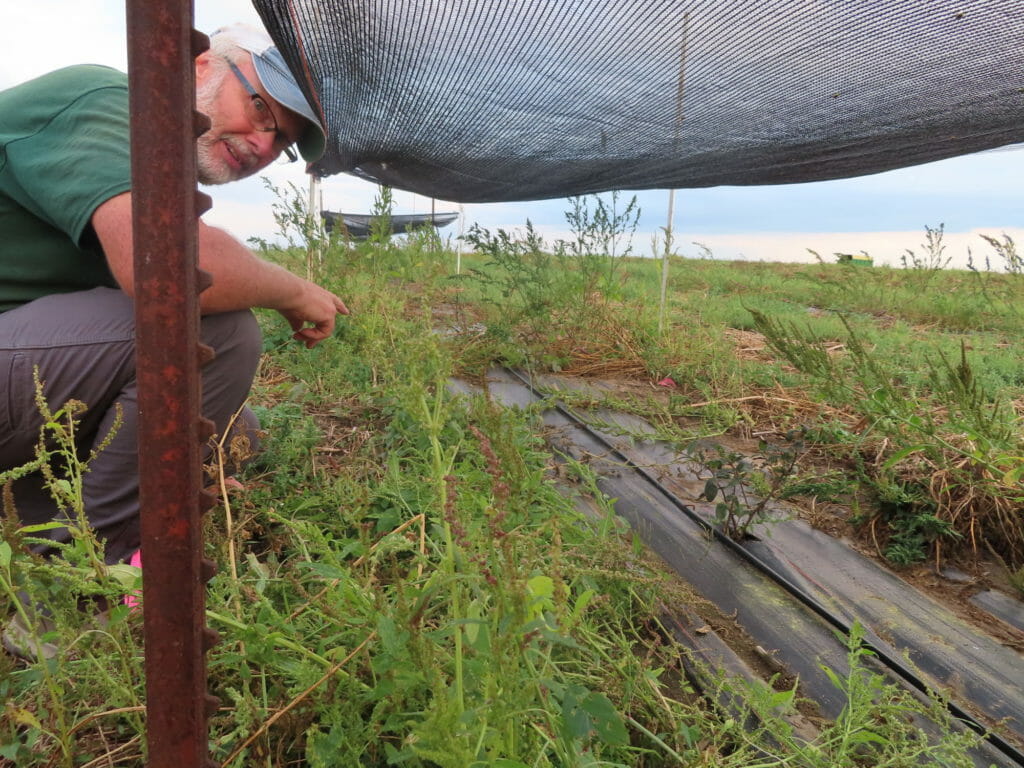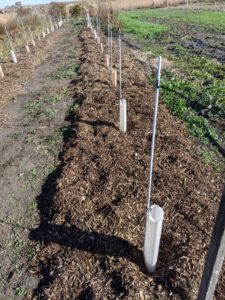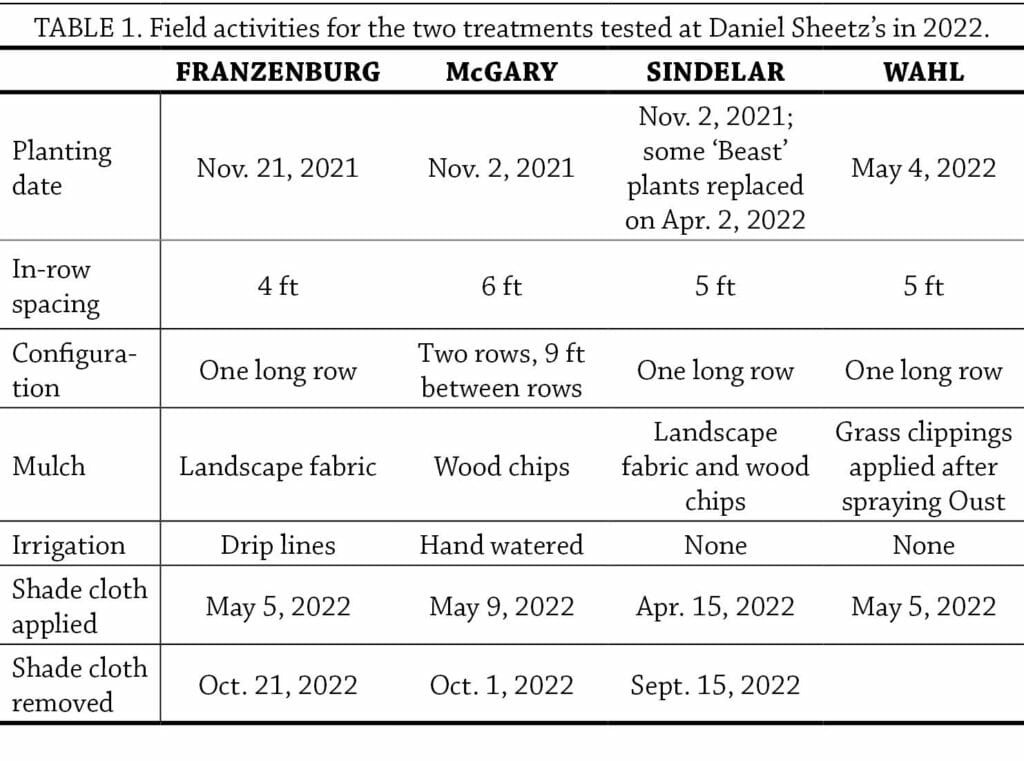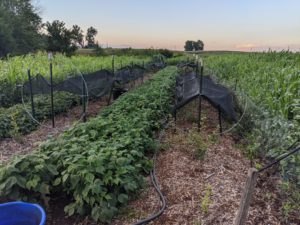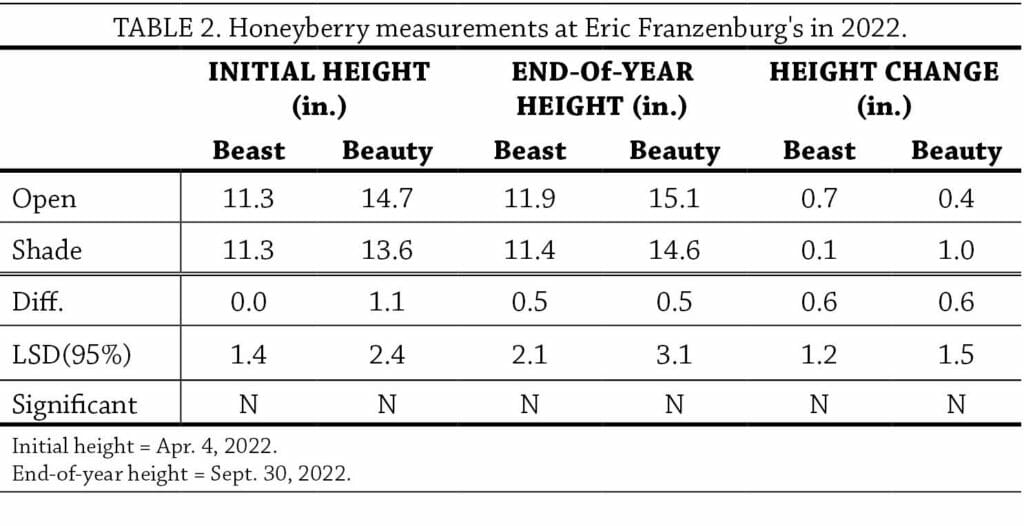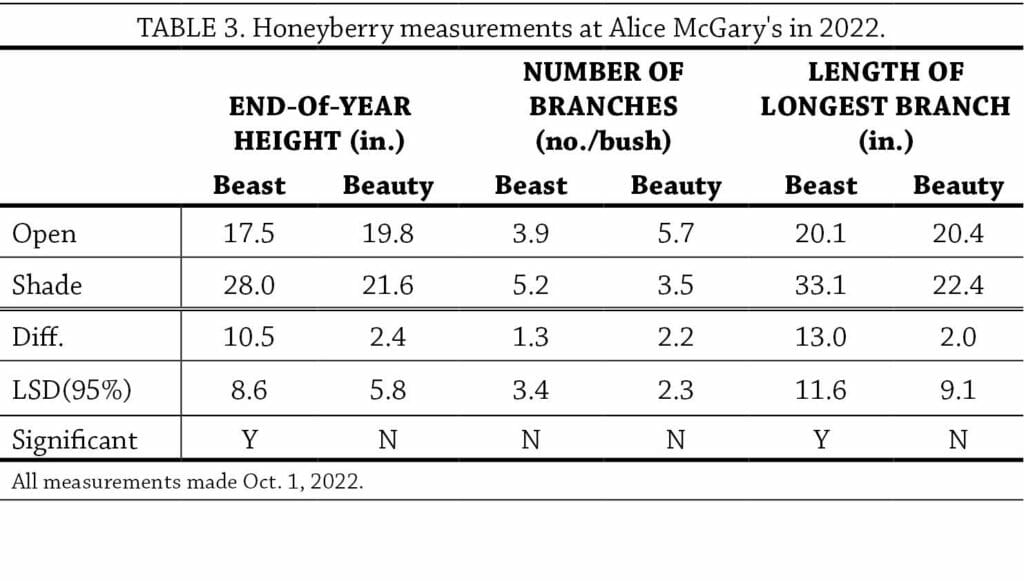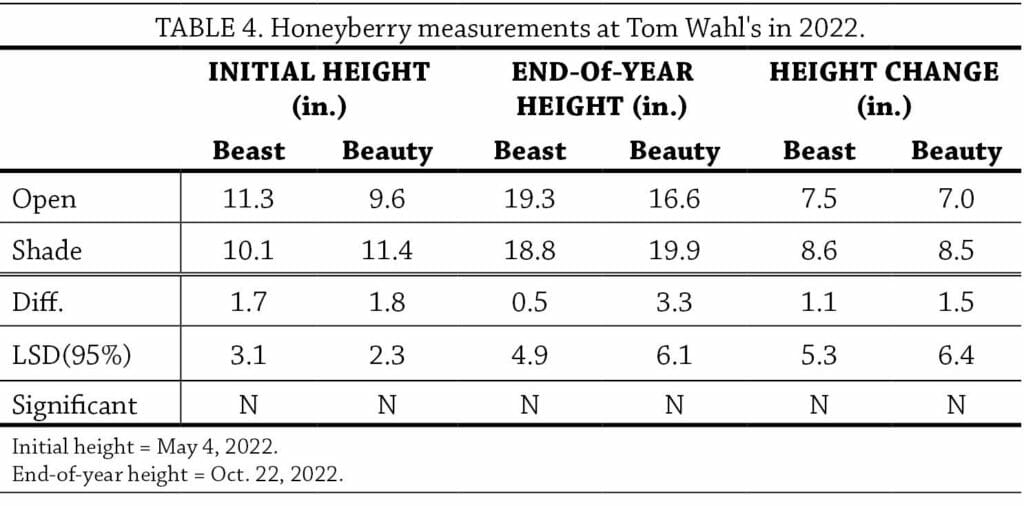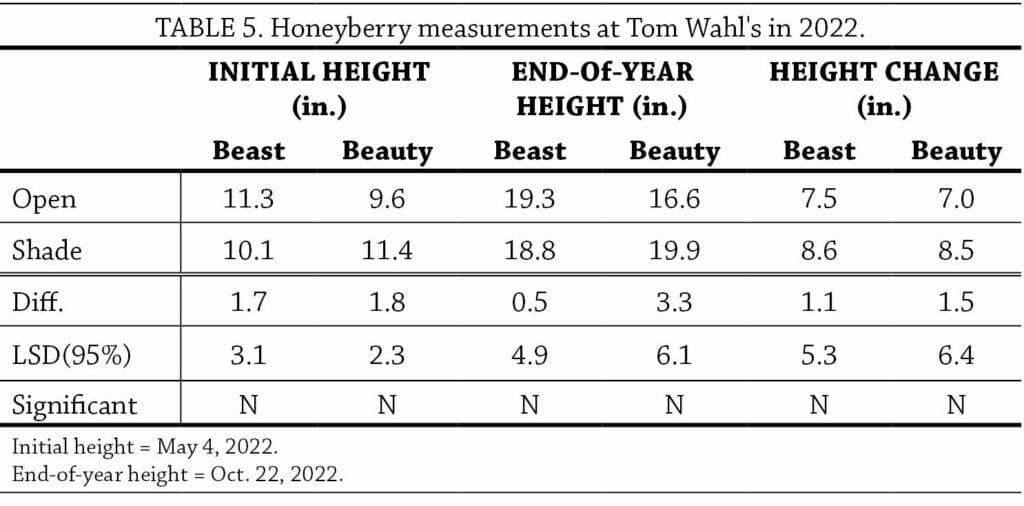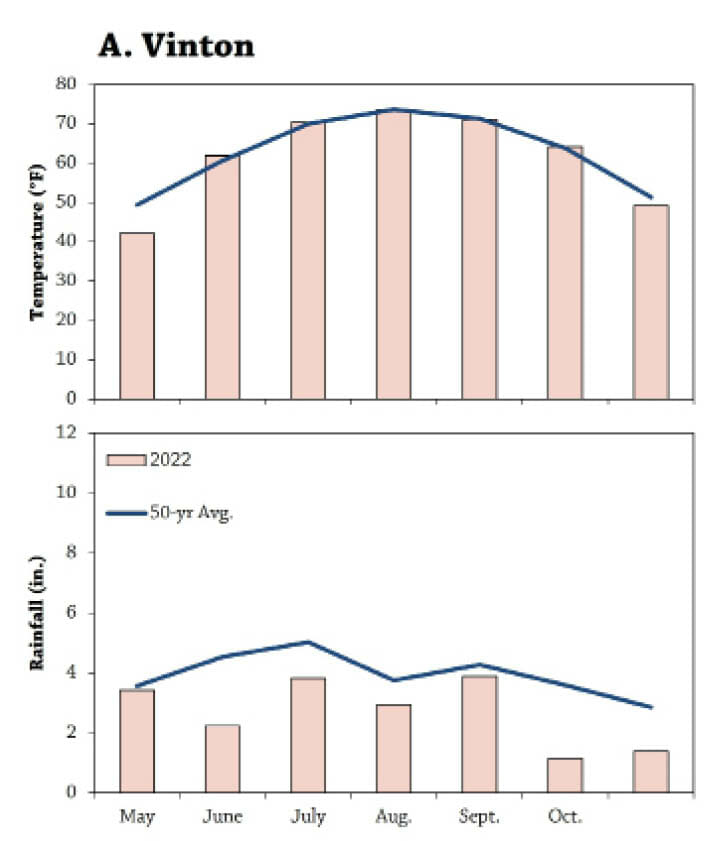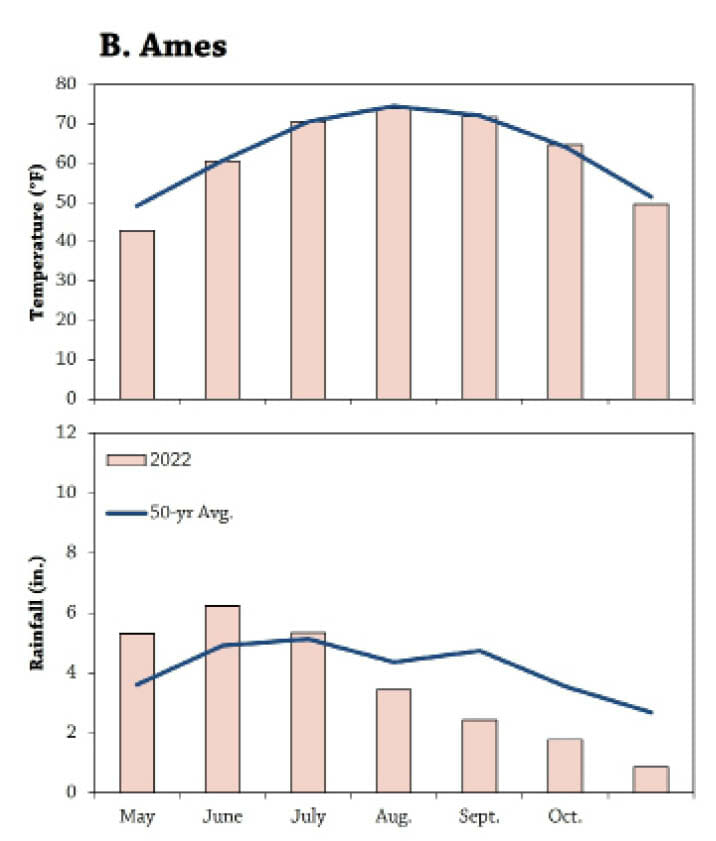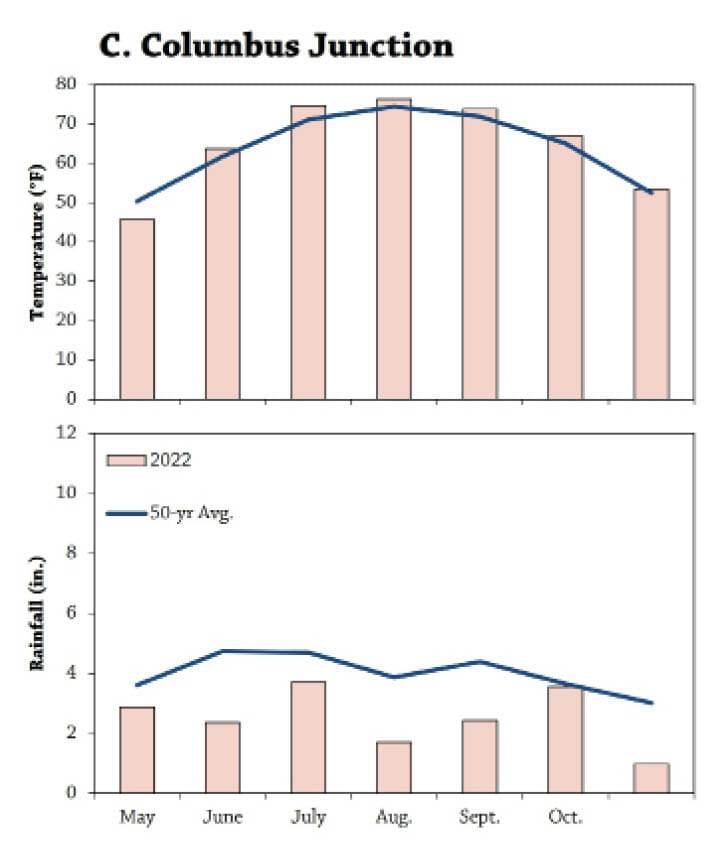This research was funded by IDALS – Specialty Crop Block Grant
In a Nutshell:
- Eric Franzenburg, Alice McGary, Jeff Sindelar and Tom Wahl were curious to learn more about raising honeyberries on their farms. The perennial berry crop is gaining attention for its potential as an early-season offering on diverse fruit and vegetable farms in the Midwest.
- The cooperators initiated a multi-year project aimed at investigating the effect of shade on honeyberry performance. Because honeyberry is native to northern, cooler climates than the Midwest, they wondered if the shade would reduce heat stress and result in healthier, more productive plants.
Key Findings:
- 2022 marked the establishment year of honeyberries at each of the four farms. McGary and Sindelar observed some increased growth of bushes grown under 40% shade cloth compared with honeyberries grown under full sun (no shade). Franzenburg and Wahl observed no effects of shade on honeyberries on their farms.
- Fruiting was not expected in the establishment year, and the project will continue in 2023 to determine if shade has any effect on fruit set.
Background
Many specialty crop farmers in Practical Farmers’ membership are seeking additions to perennial polyculture systems that produce a marketable, fresh-eating berry and extend their production season. Honeyberry, also known as haskap, is a hardy shrub known for cold-tolerance and for producing delicious, nutritious fruit early in the growing season.[1] Several growers in Iowa have small plantings of honeyberries, but scant information and research are available on varietal production and establishment, particularly in the U.S. and Zone 5. In 2022, four cooperators initiated a multi-year on-farm research project to investigate the effect of shade on the establishment and eventual fruiting performance of honeyberries.
Methods
Design
Cooperators received two-year-old honeyberry bushes from HoneyberryUSA and planted bushes in either fall 2021 or spring 2022. Because honeyberry need to be near an unrelated variety in order to maximize pollination and fruit set, each plot consisted of four bushes (two bushes each of two varieties – Boreal Beast and Boreal Beauty). To determine the effect of shade on honeyberry bushes during the establishment year, cooperators applied one of two treatments to random plots:
- Shade – Shade cloth (40% shade) applied to bushes in early spring; left on entire season and removed before onset of winter.
- Open – No cloth applied to bushes.
Each cooperator implemented four replications of the two treatments, which resulted in eight plots consisting of four bushes (two from each variety). In total, the experiment required 32 bushes. Field management for each farm is provided in Table 1.
How the shade cloth was applied differed by farm. Generally, cloths were mounted above bushes using T posts. McGary and Wahl also applied mesh seedling protectors (4-in. diameter) to all bushes near the time of transplanting to prevent damage from rabbits. Sindelar applied chicken wire around all bushes for protection.
Measurements
Franzenburg, Sindelar and Wahl measured the height of each bush at the time of transplanting. All cooperators measured the height of each bush at the end of the 2022 growing season. McGary also documented the number of branches and the length of the longest branch on each bush. Because this was the establishment year for bushes at all farms, honeyberry did not set fruit (or set only a few). Fruit setting and production will be the scope of future years of this project.
Data analysis
We evaluated the effect of the variety and shade on honeyberry growth at each farm with the least significant difference (LSD) calculated from a t-test and using a 95% confidence level. If the difference between any of the two treatments was greater than the LSD, we would expect such a difference to occur 95 times out of 100 under the same conditions – we referred to this as a statistically significant effect. Conversely, differences less than the LSD indicated the no treatment effect.
Results and Discussion
Franzenburg
Shade had no effect on honeyberry bushes at Franzenburg’s (Table 2). Beauty bushes were taller than Beast bushes initially, and because all bushes grew on average the same amount during the year, Beauty bushes were also taller than Beast bushes at the end of the year.
By the end of the year, Beast bushes under shade were taller by over 10 in. than Beast bushes that were not shaded at McGary’s (Table 3). Beauty bushes, however, were not affected by shade. Shade did not affect the number of branches on bushes for either variety. The longest branches on Beast bushes under shade were 13-in. longer than the longest branches on Beast bushes not under shade. This effect was not observed in Beauty bushes, though.
Shade only affected the change in height of Beast bushes at Sindelar’s (Table 4). Beauty bushes were initially taller than Beast bushes, but by the end of the year both varieties were of statistically similar height. This was because Beast bushes increased in height more than Beauty bushes; especially those under shade.
Wahl
No effects of shade or variety were observed at Wahl’s (Table 5). All bushes were initially similar in height and all bushes grew on average 8 in. during the season regardless of shade.
Conclusions and Next Steps
Applying shade cloth to honeyberry bushes appeared to have limited effect during the establishment year at the four farms. Franzenburg, McGary, Sindelar and Wahl did not seem surprised by this result because observable effects on perennial plants like honeyberries typically only manifest after a few years. With that in mind, each of the cooperators is eager to continue the project in 2023 to see if shading has an impact on fruit set.
Appendix – Trial Design and Weather Conditions
FIGURE A1. Mean monthly temperature and rainfall during the study period and the long-term averages at the nearest weather stations to each farm.[2] A) Vinton (Franzenburg and Sindelar); B) Ames (McGary); C) Columbus Junction (Wahl)
References
- Lauritzen, E., T. Maughan and B. Black. 2015. Haskap (Blue Honeysuckle) in the Garden. https://extension.usu.edu/yardandgarden/research/haskap-in-the-garden (accessed February 2023).
- Iowa Environmental Mesonet. 2022. Climodat Reports. Iowa State University. http://mesonet.agron.iastate.edu/climodat/ (accessed December 2022).


